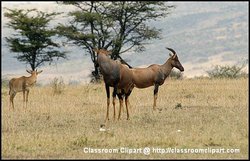Topis
|
|
| Topi Conservation status: Lower risk (cd) | ||||||||||||||||
|---|---|---|---|---|---|---|---|---|---|---|---|---|---|---|---|---|
| Scientific classification | ||||||||||||||||
| ||||||||||||||||
| Binomial name | ||||||||||||||||
| Damaliscus lunatus Burchell, 1823 |

The Topi, or Tsessebe, as it is called in Southern Africa, (Damaliscus lunatus also known as Tiang or Korrigum) is a savannah and floodplain antelope found in Sudan, Chad, Kenya, Tanzania, and Southern Africa.
Topi stand over a metre tall at the shoulder and weigh 80 to 160 kilograms. Their coats are a rusty red colour with black legs, chest and a black strip running from forehead to the tip of the nose. The horns are lyre-shaped and are conspicuously ringed and can reach 70 centimetres in both sexes.
Topi live in savannah and floodplains where they eat mainly grass. Males hold territories from a few tens of thousands of square metres to a few square kilometres. These are marked out with urine, and dung. Topi form herds of up to twenty females and calves led by a male, but thousands of Topi may come together during migration.
Males will engage in fights for territory and these are fought by lunging on to their knees while whacking each other with their horns. Topi can reach seventy kilometres an hour when frightened and will sometimes jump over each other to get away from a threat. They have the reputation of being the fastest of all antelopes.
